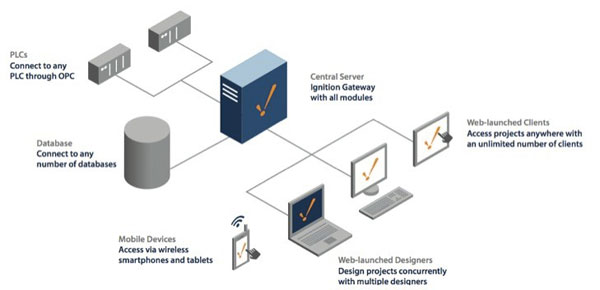
Expanding PLC functionality with networking:
Although PLCs opened the door for on-the-floor visual communication, it was their integration with networking devices that offered manufacturers a new level of visibility and control by combining real-time Ethernet with visualization, control, and communication capabilities.
To meet the growing operation needs of industrial automation, networks continue to expand, offering monitoring and control capabilities in areas not previously possible. Device networks are now using fieldbus-to-Ethernet integration to develop enterprise-wide control networks. Merging networking functionality with PLCs enables users to off-load main processor tasks for distributed control in the field, placing control-level devices closer to the action. Additionally, by combining control with distributed I/O, manufacturers can lower their total cost of operation by streamlining data acquisition, communication, and factory-wide connectivity.
Networking: For PLCs to become a networking tool, users must have the necessary bandwidth that allows real-time industrial Ethernet. Because connection and communication requirements are expanding, PLCs must increase support for multiple network technologies. While there is no one-size-fits-all industrial network for all of the advanced I/O solutions, PLCs can connect the enterprise layer to the plant as needed by accommodating multiple protocols. Because network protocols add functionality, PLCs are necessary components for driving and supporting these additional functions.
Maintaining these industrial automation networks continues to be a key component in ensuring these integrated system continue functioning. A reliable network is paramount. Therefore, maintaining network availability is crucial. This requires the system to support the necessary bandwidth and high data transmission rates to meet application specifications, as well as data protection during maintenance operations and fast recoveries if connection failures occur.
Along with speed and availability, redundancy is important for continued performance and reliability. Prolonged periods of unplanned system downtime can become a potential threat to plant productivity. However, redundancy technologies not only provide msec-level network recovery, but they can also substantially reduce deployment costs.
Students will learn how to select the proper real time network for the application and implement the desired performance; capacity and robustness for horizontal and vertical integration.
LEARNING OBJECTIVES
Students who attend our Real Time Networking training course will understand how to use network, in real time, various devices in larger automated industrial electrical systems. Our intensive two-day training courses uses a combination of interactive exercises, practical applications, and case studies.
Our Real Time Networking Training Course Students will learn:
Automation specialists in the industrial, consulting, and utility fields involved in design, operation and maintenance who require knowledge of electrical system automation techniques.
Real Time Networking Training Program
DAY ONE
Session 1: Introduction to Real Time Networking
Session 2: Typical requirements and applications for deterministic networks
Session 3: Most important Protocols used in Real Time Networking
Session 4: Parameters and Settings of Allen Bradley Real Time Networks
Session 5: Applications of Allen Bradley Networks
Session 6: Parameters of Rockwell Real Time Networks
Session 7: Implementation and structures of Allen Bradley & Rockwell Networks
Session 8: Hardware Selection; Topology and Software required to implement Rockwell Real Time Network
Session 9: Bridges and Convertors for real time Networks
Session 10: Modbus Networks and applications
Session 11: Profibus Networks and applications
Session 12: Software protocol convertors
Session 13: Keep Server example of implementation for Oil Extraction Application
Session 14: HART communications and applications
DAY TWO
Session 15: Implementation of a Control Net Real time network
Session 16: Hardware planning and configuration for Control Net
Session 17: Setting up the Keeper for Control Net
Session 18: Using Real Time Networks in a Plant PAX Application
Session 19: Other Real time Networks and Applications:
Session 20: Industrial Ethernet, parameters, performance and applications
Session 21: RS-Networks for Device Net and ETH, application
Session 22: Debugging Control net Network
Session 23: Debugging Device net Network
Session 24: Stratix 8000 and CISCO Routers for real time applications
Session 25: Integrating a multiprotocol Real Time netwok
Session 26: Example of integration of a multi network Real time network
Session 27: Wireless; Blue Tooth and Radio communication pros and cons
COURSE TIMETABLE
Both days:
Start: 8:00 a.m.
Coffee Break: 10:00 a.m.
Lunch: 12:00 noon (not included with course)
Restart: 1:15 p.m.
Finish: 4:30 p.m.